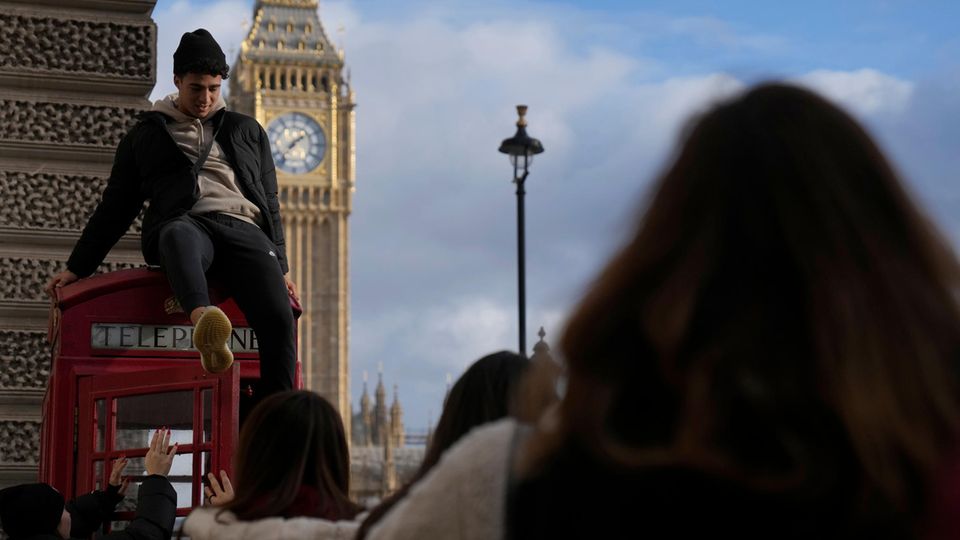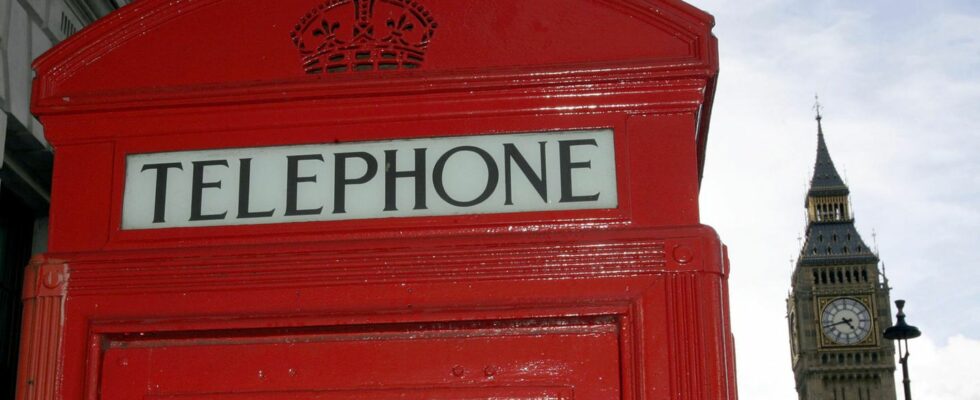Cult box celebrates its birthday
The red telephone box is 100 years old
Charismatic, but useless: Red telephone boxes are part of the British cityscape
© Frank May / DPA
What is red and typically British? That’s right, the telephone booths! There are still 3,000 of the red boxes across the UK – and the number is falling. But a few will always remain.
In Kingston-upon-Thames, people apparently already suspected the course of events. Like a row of falling dominoes, several red Telephone boxes are arranged. The installation is called “Out of Order”, which can be translated as “out of order”. The fact is: as charismatic as they are, the British icon is hardly ever really needed in the age of smartphones and mobile internet. And so there is a bit of sadness as the cult box celebrates its anniversary.
This Thursday (May 23) marks 100 years since architect Giles Gilbert Scott submitted his design for Kiosk No 2. The technically banal name K2 is shortened. This is reminiscent of the famous eight-thousand-meter peak in the Himalayas, but the risk of confusion is likely to be low.
Long lines for a photo with the red box
One thing is clear: the red telephone boxes belong to Great Britain like the royals and tea. Without them, tourists can hardly imagine the streetscape of London. One of the best-known boxes is in the Westminster government district and even has its own entry on an online mapping service – when the weather is nice, visitors queue in long queues to take a photo with a view of Parliament and Big Ben.
Voted the greatest British design in history in 2015, its importance had long since diminished. The authorities estimate that there are still around 3,000 of the boxes nationwide, but the number is constantly falling. No connection under this number? This is also why the telecommunications giant BT launched its adoption program for the cells a good 15 years ago.
Telephone booth becomes mini library
Since then, thousands of “red boxes” have been purchased by municipalities and organizations for the symbolic price of one pound (1.17 euros). British imagination knows no bounds: the phone boxes have been preserved as mini libraries, defibrillator locations, greenhouses, and even small museums. Some examples have even been installed in apartments as showers. The former “eye-catcher” is increasingly rarely seen on the streets. Londoners somewhat wistfully compare the development with the equally famous red double-deckers and black taxis – they still drive through the British capital in large numbers, but increasingly in other colors.

In Kingston-Upon-Thames, several telephone boxes lean against each other like overturned dominoes
© Benedikt von Imhoff / DPA
In fact, K2 was not actually supposed to shine in the familiar red. “Scott’s winning design was originally supposed to be made of silver-painted steel with a blue-green interior,” the British government reports. Only after the selection process did the General Post Office, which was responsible at the time, decide to make the box out of cast iron and paint it red.
Inspiration from a grave
Scott (1880-1960) had designed the building for a competition held by the Royal Fine Arts Commission at the request of the Postmaster General to find an alternative to Kiosk No. 1. The concrete cell had only been introduced in 1921, but was extremely unpopular. Scott was supposedly inspired by the family tomb that the architect John Soane, who designed the Bank of England building, among other things, had built for his wife in 1816. Scott knew the building well – he was a trustee of Sir John Soane’s Museum for decades.

Whatsapp? The phone booth is over there!
01:12 minutes
K2 soon convinced. The red matched the equally iconic red mailboxes and red buses. However, the impressive design, which featured King George V’s royal coat of arms on all four sides, could only be seen in the capital. At one British ton, the cell was simply too heavy and expensive for nationwide use. Nevertheless, K2 served as the basis for the next generations of the red box.
K8 marked the end of the series
In 1935, the Post Office commissioned Scott to build a new telephone box to celebrate the Silver Jubilee of King George V. The “K6 Jubilee Kiosk” was similar to the K2, made of cast iron and painted red, but weighed around three quarters of a tonne, significantly lighter. Larger windows let in more light. By the end of the 1930s, around 20,000 K6 telephone boxes were in use in the United Kingdom – and the installation in Kingston is made up of discarded K6s. The last “red telephone box” was the K8, introduced in 1968 by architect Bruce Martin, which only had one large window on three sides.

Popular photo motif: the red telephone box in front of Big Ben in London
© Alastair Grant / AP / DPA
Even though people are making phone calls in them less and less, the iconic cells are not going to die out. The government has placed some of them under monument protection. Because, as a passerby in Kingston once said: “They are part of the blood, body and structure of Great Britain.”

